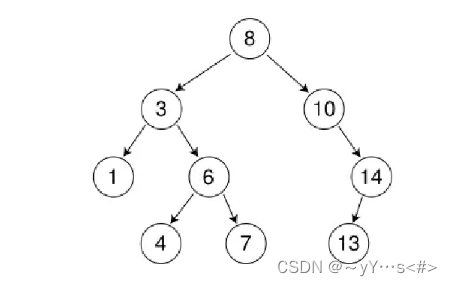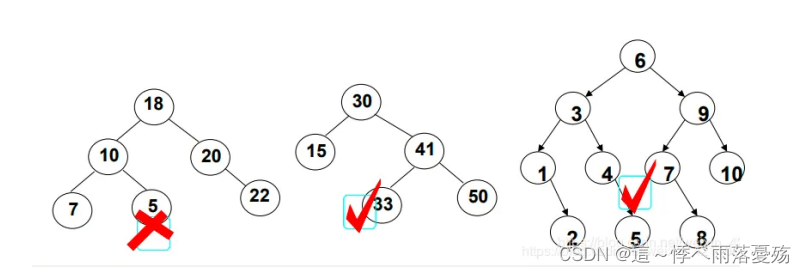目录
为了更好地理解 map 和 set 的特性,和后面讲解查找效率极高的平衡搜索二叉树,和红黑树去实现模拟,所以决定在这里对搜索二叉树进行一个讲解~
1.定义
二叉搜索树(Search Binary Tree)
每一颗子树都满足,左子树上所有节点的值都小于根节点的值,右子树都大于
所以就能得到性质:左子树的值 < 根 < 右子树的值
它也称二叉排序树或二叉查找树,最多找高度次 O(N)
二叉搜索树蜕化为单边树(或类似单边),其平均比较次数为:O(N)
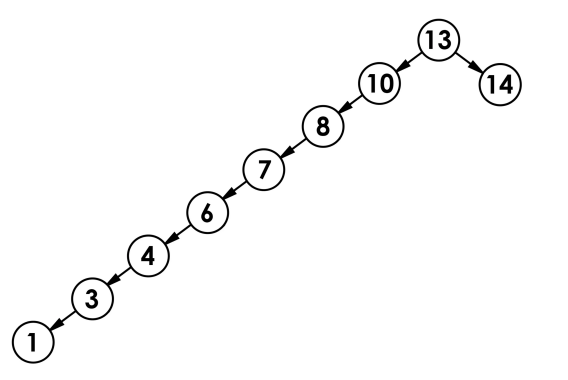
搜索二叉树由于控制不了极端情况,与 O(logN) 失之交臂了,但后面讲到的平衡二叉搜索树可以做到。
初始化
template<class K>
struct BSTreeNode
{//全部都共有开放的,就直接定struct
BSTreeNode<K>* _left;//左结构体指针
BSTreeNode<K>* _right;
K _key;
BSTreeNode(const K& key)
:_left(nullptr)
,_right(nullptr)
,_key(key)
{}
};
//定义一个树
template<class K>
class BATree{
typedef BSTreeNode<K> Node;
private:
Node* _root = nullptr; // 这里我们构造函数都没必要写,它自己生成的就够用了
};插入
思路:
- 检查是否有根结点 _root,如果没有我们就 new 一个结点出来作为根结点。
- 插入就需要找到插入位置,我们定义一个 cur 变量,从根节点开始,
根据搜索二叉树 性质,将 cur 结点的 key 与插入的值 key 进行大小比较 - 仅仅 new 上一个新结点给 cur 是完成不了插入操作的!需要 cur 跟上一层(cur 的父亲)相链接才行!为了能找到上一层,所以我们还需要额外定义一个 parent 变量来记录 cur 的父结点
在我们更换 cur 结点时记录父结点的位置
parent=cur即可。parent 意义:确认位置,实现插入
4.比较确定 cur 应该链接父亲的左边,还是链接父亲的右边,插入即可
//插入
bool Insert(const K& key)
{
//没有根节点就new一个
if (_root == nullptr)
{
_root = new Node(key);
return true;
}
Node* parent = nullptr;
Node* cur = _root;
//循环比较
while (cur)
{
if (cur->_key < key)
{
parent = cur;
cur = cur->_right;//小了就应该往右找
}
else if(cur->_key > key)
{
parent = cur;
cur = cur->_left;
}
else
{
return false;
}//不断比较,搜索找到了之后
}
//new了一个新节点,和parent的key比较,确定插入的左右
cur = new Node(key);
if (parent->_key < key)
{
parent->_right = cur;
}
else
{
parent->_left = cur;
}//将新节点插入到二叉树里面啦
return true;
}再写一个中序遍历来测试一下插入的效果:
void InOrder(Node* root) {
if (root == nullptr) {
return;
}
InOrder(root->_left); // 左
cout << root->_key << " "; // 值
InOrder(root->_right); // 右
}
//测试
void TestBSTree() {
BSTree<int> t;
int a[] = { 8, 3, 1, 10, 6, 4, 7, 14, 13 };
for (auto e : a) {
t.Insert(e);
}
t.InOrder(); ❌ 没法传根
}此时会出现一个问题,因为根是私有的,我们没办法把根传过去,我们可以采取 getroot,这里的话,我们将其设为内部函数即可
void InOrder() {
_InOrder(_root);
}
private:
// 改为内部函数
void _InOrder(Node* root) {
if (root == nullptr) {
return;
}
_InOrder(root->_left);
cout << root->_key << " ";
_InOrder(root->_right);
}
Node* _root = nullptr;
};完整测试代码:
#include <iostream>
using namespace std;
template<class K>
struct BSTreeNode {
BSTreeNode<K>* _left;
BSTreeNode<K>* _right;
K _key;
BSTreeNode(const K& key)
: _left(nullptr)
, _right(nullptr)
, _key(key)
{}
};
template<class K>
class BSTree {
typedef BSTreeNode<K> Node;
public:
BSTree() : _root(nullptr) {}
bool Insert(const K& key) {
if (_root == nullptr) {
_root = new Node(key);
return true;
}
Node* parent = nullptr;
Node* cur = _root;
//设置结构体形的cur节点,并进行初始化
while (cur) {
if (cur->_key < key) {
parent = cur;
cur = cur->_right;
}
else if (cur->_key > key) {
parent = cur;
cur = cur->_left;
}
else {
return false; // Key already exists
}
}
cur = new Node(key);
if (parent->_key < key) {
parent->_right = cur;
}
else {
parent->_left = cur;
}
return true;
}
void InOrder() {
_InOrder(_root);
cout << endl;
}
private:
void _InOrder(Node* root) {
if (root == nullptr) {
return;
}
_InOrder(root->_left);
cout << root->_key << " ";
_InOrder(root->_right);
}
Node* _root;
};
// 测试函数
void TestBSTree() {
BSTree<int> t;
int a[] = { 8, 3, 1, 10, 6, 4, 7, 14, 13 };
for (auto e : a) {
t.Insert(e);
}
t.InOrder();
}
int main() {
TestBSTree();
return 0;
}打印:

查找
从根开始,如果要查找的值大于 cur 目前的值,则让 cur 往右走,反之往左走。
当查找得值与 cur 的值相等时则说明找到了,返回 true。
当 cur 触及到空(while 循环结束)则说明找不到,返回 false。
//查找
bool Find(const K& key)
{
Node* cur = _root;//从根开始
while (cur)
{//循环查找
if (cur->_key < key)
{
cur = cur->_right;
}
else if (cur->_key > key)
{
cur = cur->_left;
}
else
{
return true;
//找到啦
}
}
return false;
//为空了还没找到就退出
}删除
搜索二叉树删除的实现是有难度的,删除的实现就需要一些技巧了,断然删除会毁树。
我们可以以下面这棵树为例
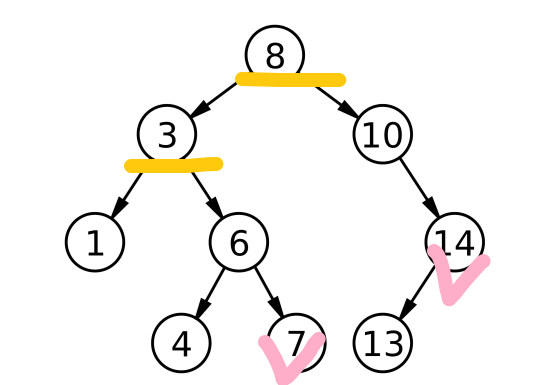
分别一次删除 7,14,3,8
7 和 14 属于直接删除的场景
3,8 属于需要替换法进行删除的场景
总结:
没有孩子,或者一个孩子都好删(直接删,托孤即可)
两个孩子以上就要采取替换法(左子树的最大节点,或者右子树的最小节点)
1.该结点无左孩子
- 若该结点为 root,直接让 root 等于它的右孩子结点。(一定要先判断)
画忘了,画成右为空了qwq,大家同理的理解一下
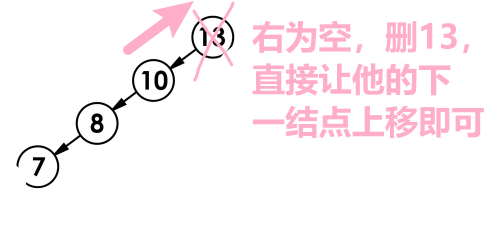
// 左为空
if (cur->_left == nullptr)
{
if (cur == _root)
{//如果是根节点,parent就变为空了
_root = cur->_right;
}
else- 判断 cur 是在父节点的左还是右支,判断后将其指向parent->right/left = cur->right ,直接将右边连过去,实现重新连接的延续
- 最后删除 cur 结点
if (cur->_left == nullptr) {//该结点无左孩子
/* 判断要删除的结点是否为根结点 */
if (cur == _root) {
_root = cur->_right;
}
else {
if (cur == father->_right) {
//判断他是上一个节点的左节点还是右节点
father->_right = cur->_right;
}
else {
father->_left = cur->_right;
}
}
delete cur;
cur = nullptr;
}左右都不为空--替换法
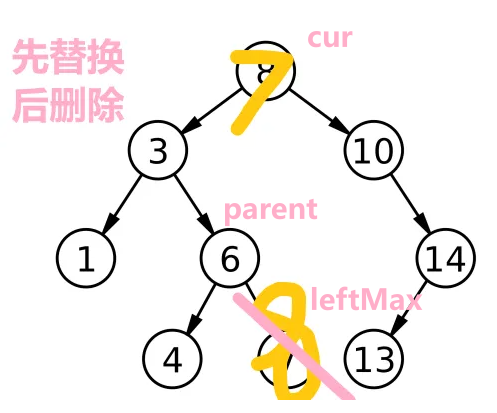
else
{
//查找到左边的最右节点
//右边的最左节点
//交换
//删除
// 找替代节点
Node* parent = cur;
//不能设置为nullptr,循环可能不进去了
//之后要对父节点进行处理
Node* leftMax = cur->_left;
//设置最大节点
while (leftMax->_right)
{
parent = leftMax;
leftMax = leftMax->_right;
//即最右节点
}
//交换key
swap(cur->_key, leftMax->_key);删除的判断
//将parent置空处理,断联
if (parent->_left == leftMax)
{
parent->_left = leftMax->_left;
}
else
{
parent->_right = leftMax->_left;
}
//删除cur的处理
cur = leftMax;
}
delete cur;
return true;
}
}
return false;完整代码
#pragma once
template<class K>
struct BSTreeNode
{
BSTreeNode<K>* _left;
BSTreeNode<K>* _right;
K _key;
BSTreeNode(const K& key)
:_left(nullptr)
,_right(nullptr)
,_key(key)
{}
};
template<class K>
class BSTree
{
typedef BSTreeNode<K> Node;
public:
BSTree()
:_root(nullptr)
{}
bool Insert(const K& key)
{
if (_root == nullptr)
{
_root = new Node(key);
return true;
}
Node* parent = nullptr;
Node* cur = _root;
while (cur)
{
if (cur->_key < key)
{
parent = cur;
cur = cur->_right;
}
else if(cur->_key > key)
{
parent = cur;
cur = cur->_left;
}
else
{
return false;
}
}
cur = new Node(key);
if (parent->_key < key)
{
parent->_right = cur;
}
else
{
parent->_left = cur;
}
return true;
}
bool Find(const K& key)
{
Node* cur = _root;
while (cur)
{
if (cur->_key < key)
{
cur = cur->_right;
}
else if (cur->_key > key)
{
cur = cur->_left;
}
else
{
return true;
}
}
return false;
}
bool Erase(const K& key)
{
Node* parent = nullptr;
Node* cur = _root;
while (cur)
{
if (cur->_key < key)
{
parent = cur;
cur = cur->_right;
}
else if (cur->_key > key)
{
parent = cur;
cur = cur->_left;
}
else // 找到了
{
// 左为空
if (cur->_left == nullptr)
{
if (cur == _root)
{
_root = cur->_right;
}
else
{
if (parent->_right == cur)
{
parent->_right = cur->_right;
}
else
{
parent->_left = cur->_right;
}
}
}// 右为空
else if (cur->_right == nullptr)
{
if (cur == _root)
{
_root = cur->_left;
}
else
{
if (parent->_right == cur)
{
parent->_right = cur->_left;
}
else
{
parent->_left = cur->_left;
}
}
} // 左右都不为空
else
{
// 找替代节点
Node* parent = cur;
Node* leftMax = cur->_left;
while (leftMax->_right)
{
parent = leftMax;
leftMax = leftMax->_right;
}
swap(cur->_key, leftMax->_key);
if (parent->_left == leftMax)
{
parent->_left = leftMax->_left;
}
else
{
parent->_right = leftMax->_left;
}
cur = leftMax;
}
delete cur;
return true;
}
}
return false;
}
void InOrder()
{
_InOrder(_root);
cout << endl;
}
void _InOrder(Node* root)
{
if (root == NULL)
{
return;
}
//递归实现中序遍历的打印
_InOrder(root->_left);
cout << root->_key << " ";
_InOrder(root->_right);
}
private:
Node* _root;
};测试:
void TestBSTree1()
{
int a[] = { 8, 3, 1, 10, 6, 4, 7, 14, 13 };
BSTree<int> t;
for (auto e : a)
{
t.Insert(e);
}
t.InOrder();
t.Erase(4);
t.InOrder();
t.Erase(6);
t.InOrder();
t.Erase(7);
t.InOrder();
t.Erase(3);
t.InOrder();
for (auto e : a)
{
t.Erase(e);//插入
}
t.InOrder();
}运行:
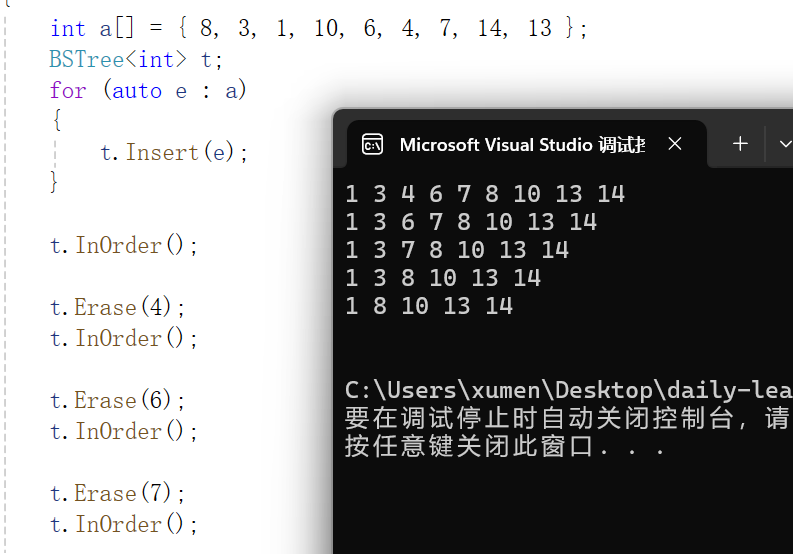
2.运用
K 模型和 KV 模型详解
K 模型
K 模型指的是只有 key 作为关键码的结构,在这种结构中只存储 key。K 模型常用于需要搜索具体值的场景,比如拼写检查、数字搜索等。
示例代码:K 模型的二叉搜索树
以下是一个实现 K 模型的二叉搜索树(BST)的完整代码示例:
#include <iostream>
using namespace std;
template<class K>
struct BSTreeNode {
BSTreeNode<K>* _left;
BSTreeNode<K>* _right;
K _key;
BSTreeNode(const K& key)
: _left(nullptr)
, _right(nullptr)
, _key(key)
{}
};
template<class K>
class BSTree {
typedef BSTreeNode<K> Node;
public:
BSTree() : _root(nullptr) {}
bool Insert(const K& key) {
if (_root == nullptr) {
_root = new Node(key);
return true;
}
Node* parent = nullptr;
Node* cur = _root;
while (cur) {
if (cur->_key < key) {
parent = cur;
cur = cur->_right;
}
else if (cur->_key > key) {
parent = cur;
cur = cur->_left;
}
else {
return false; // Key already exists
}
}
cur = new Node(key);
if (parent->_key < key) {
parent->_right = cur;
}
else {
parent->_left = cur;
}
return true;
}
void InOrder() {
_InOrder(_root);
cout << endl;
}
private:
void _InOrder(Node* root) {
if (root == nullptr) {
return;
}
_InOrder(root->_left);
cout << root->_key << " ";
_InOrder(root->_right);
}
Node* _root;
};
// 测试函数
void TestBSTree() {
BSTree<int> t;
int a[] = { 8, 3, 1, 10, 6, 4, 7, 14, 13 };
for (auto e : a) {
t.Insert(e);
}
t.InOrder();
}
int main() {
TestBSTree();
return 0;
}KV 模型
KV 模型表示每一个关键码 (key) 都有与之对应的值 (value),即 <Key, Value> 的键值对。这种结构常用于字典、映射、统计等场景。
示例代码:KV 模型的二叉搜索树
以下是一个实现 KV 模型的二叉搜索树的完整代码示例:
#include <iostream>
#include <string>
using namespace std;
template<class K, class V>
struct BSTreeNode {
BSTreeNode<K, V>* _left;
BSTreeNode<K, V>* _right;
K _key;
V _value;
BSTreeNode(const K& key, const V& value)
: _left(nullptr)
, _right(nullptr)
, _key(key)
, _value(value)
{}
};
template<class K, class V>
class BSTree {
typedef BSTreeNode<K, V> Node;
public:
BSTree() : _root(nullptr) {}
bool Insert(const K& key, const V& value) {
if (_root == nullptr) {
_root = new Node(key, value);
return true;
}
Node* parent = nullptr;
Node* cur = _root;
while (cur) {
if (cur->_key < key) {
parent = cur;
cur = cur->_right;
}
else if (cur->_key > key) {
parent = cur;
cur = cur->_left;
}
else {
cur->_value = value; // Update value if key already exists
return true;
}
}
cur = new Node(key, value);
if (parent->_key < key) {
parent->_right = cur;
}
else {
parent->_left = cur;
}
return true;
}
bool Find(const K& key, V& value) {
Node* cur = _root;
while (cur) {
if (cur->_key < key) {
cur = cur->_right;
}
else if (cur->_key > key) {
cur = cur->_left;
}
else {
value = cur->_value;
return true;
}
}
return false;
}
void InOrder() {
_InOrder(_root);
cout << endl;
}
private:
void _InOrder(Node* root) {
if (root == nullptr) {
return;
}
_InOrder(root->_left);
cout << "<" << root->_key << ", " << root->_value << "> ";
_InOrder(root->_right);
}
Node* _root;
};
// 测试函数
void TestKVTree() {
BSTree<string, string> dict;
dict.Insert("apple", "苹果");
dict.Insert("banana", "香蕉");
dict.Insert("cherry", "樱桃");
string value;
if (dict.Find("banana", value)) {
cout << "banana: " << value << endl;
}
dict.InOrder();
}
int main() {
TestKVTree();
return 0;
}代码解释
- 节点结构定义:
template<class K, class V>
struct BSTreeNode {
BSTreeNode<K, V>* _left;
BSTreeNode<K, V>* _right;
K _key;
V _value;
BSTreeNode(const K& key, const V& value)
: _left(nullptr)
, _right(nullptr)
, _key(key)
, _value(value)
{}
};-
- 这是一个模板结构,表示二叉搜索树的节点。每个节点包含一个键值对 (key, value) 以及指向左子节点和右子节点的指针。
- 二叉搜索树类定义:
template<class K, class V>
class BSTree {
typedef BSTreeNode<K, V> Node;
public:
BSTree() : _root(nullptr) {}-
- 这是一个模板类,表示二叉搜索树。包含根节点指针
_root以及插入、查找和中序遍历的方法。
- 这是一个模板类,表示二叉搜索树。包含根节点指针
- 插入方法:
bool Insert(const K& key, const V& value) {
if (_root == nullptr) {
_root = new Node(key, value);
return true;
}
Node* parent = nullptr;
Node* cur = _root;
while (cur) {
if (cur->_key < key) {
parent = cur;
cur = cur->_right;
}
else if (cur->_key > key) {
parent = cur;
cur = cur->_left;
}
else {
cur->_value = value; // Update value if key already exists
return true;
}
}
cur = new Node(key, value);
if (parent->_key < key) {
parent->_right = cur;
}
else {
parent->_left = cur;
}
return true;
}-
- 插入方法用于将新的键值对插入到树中。通过比较键值确定新节点应该插入的位置。如果键已存在,则更新其对应的值。
- 查找方法:
bool Find(const K& key, V& value) {
Node* cur = _root;
while (cur) {
if (cur->_key < key) {
cur = cur->_right;
}
else if (cur->_key > key) {
cur = cur->_left;
}
else {
value = cur->_value;
return true;
}
}
return false;
}-
- 查找方法用于查找指定键的值。如果找到该键,则返回对应的值。
- 中序遍历方法:
void InOrder() {
_InOrder(_root);
cout << endl;
}
private:
void _InOrder(Node* root) {
if (root == nullptr) {
return;
}
_InOrder(root->_left);
cout << "<" << root->_key << ", " << root->_value << "> ";
_InOrder(root->_right);
}-
- 中序遍历方法用于遍历树并输出键值对。递归地遍历左子树、访问根节点、然后遍历右子树。
- 测试函数:
void TestKVTree() {
BSTree<string, string> dict;
dict.Insert("apple", "苹果");
dict.Insert("banana", "香蕉");
dict.Insert("cherry", "樱桃");
string value;
if (dict.Find("banana", value)) {
cout << "banana: " << value << endl;
}
dict.InOrder();
}
int main() {
TestKVTree();
return


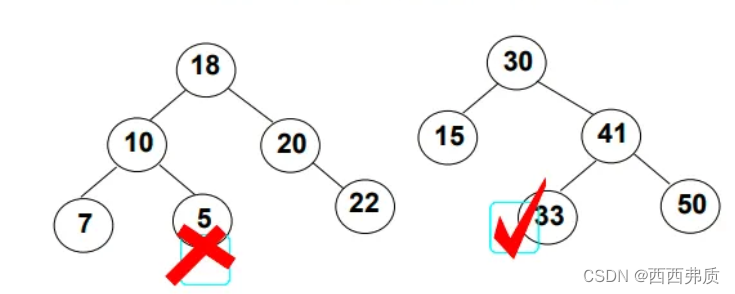
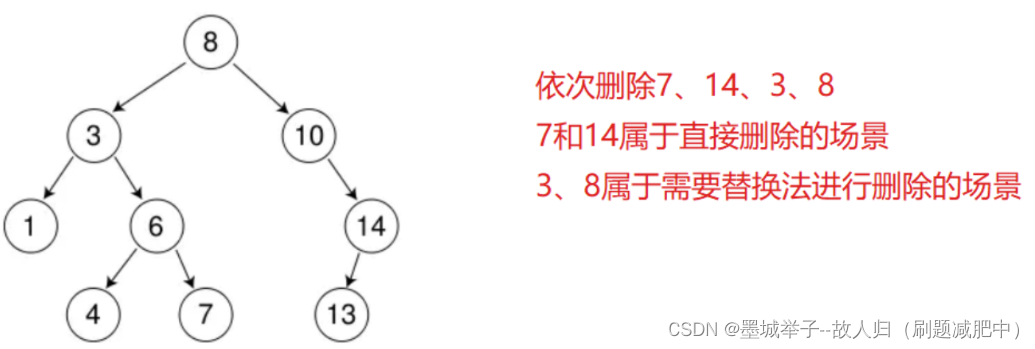
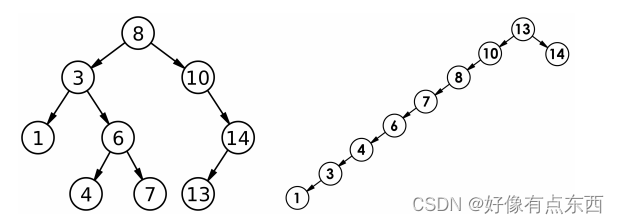

![[<span style='color:red;'>C</span>++]<span style='color:red;'>二</span><span style='color:red;'>叉</span><span style='color:red;'>搜索</span><span style='color:red;'>树</span>](https://img-blog.csdnimg.cn/direct/6a5be3369a064765bb55ef13cb9d8460.png)
